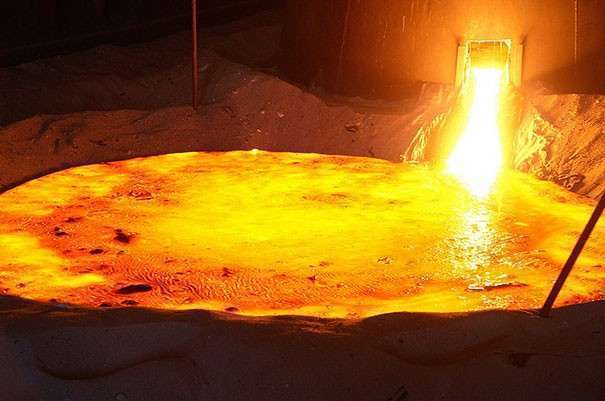In nature, most metals exist in the form of chemical compounds. Therefore, in order to be able to use them in the future, a person had to find ways to obtain metals from ores.
-
Native metals are those that exist in a free state in nature (copper, mercury, silver, gold, platinum, and others). For gold mining, either mechanical separation from impurities or extraction using reagents is used.
-
The remaining metals are presented in the form of ores – minerals or various rocks, which contain metal compounds, from which they can be extracted industrially. Most often, ores contain metal oxides or their salts (carbonates, sulfides, etc.). Often, ores contain compounds of several metals, then they are called polymetallic (lead-silver, copper-zinc, etc.).
-
The main methods for obtaining metals from ores are associated with their reduction from oxides with the help of carbon: cast iron is smelted from iron ore, tin from tin stone, and other metals from their oxides.
-
When metal is obtained from sulfur ore, it is first converted into a sulfur compound by firing in a special furnace.
Metallurgy
Obtaining metals from ores is a task of metallurgy. This term refers to both the science of industrial methods for producing metals, and the branch of industry directly dedicated to this.
Any metallurgical process is reduced to the reduction of metal cations by various reducing agents. To carry out the process of obtaining metal from ore, it is necessary to select a reducing agent in accordance with the activity of the metal, take into account environmental and economic factors, as well as the technological feasibility of the process.
Technologies for obtaining metals:
- pyrometallurgical;
- hydrometallurgical;
- electrometallurgical.
In pyrometallurgy, recovery from metal ore occurs at high temperatures and reducing agents (carbon, hydrogen, carbon dioxide, magnesium or aluminum). For example, copper is obtained from cuprite Cu2O, and tin is obtained from cassiterite SnO2 by calcining them with coke (carbon). It is also important to distinguish metal from non-metal.
Video about methods for obtaining metals from ores
Sulfide ores are first roasted with air, and the resulting oxide is reduced with coal. Carbonate ores are also calcined with coal: at high temperatures, carbonates decompose, forming oxides, which are already reduced by coal. With the help of carbon reduction, it is possible to obtain such elements as iron, zinc, copper, cadmium, lead, tin, germanium and other metals that do not form strong carbides with carbon. Active metals and hydrogen can also act as reducing agents. With this method, a fairly pure metal can be isolated. Typically, aluminum is used, which has a very high heat of oxide formation.
Hydrometallurgy
She is engaged in the recovery of metals from their aqueous salt solutions. This process is divided into two stages:
- the ore compound is dissolved in the corresponding reagent, resulting in a metal salt solution;
- the metal from the resulting solution is displaced by a more active metal, or electrolytic reduction occurs.
For example, in order to obtain pure copper from an ore containing CuO, the former is treated with dilute sulfuric acid. Then pure copper is obtained from the sulfate solution by electrolysis or displacement by iron. Zinc, silver, molybdenum, uranium and gold are obtained using a similar technology.
Electrometallurgy
This is the name of the recovery of metals by electrolysis of a melt or solution of their compounds. So, it is possible to obtain metals from ores of alkali and alkaline earth metals and aluminum. Melts of metal hydroxides, oxides or chlorides undergo electrolysis.
Obtaining alkali metals

- Lithium is obtained in vacuum from oxide or by electrolysis of its chloride, which is obtained by processing spodumene.
- By calcining soda and coal in a tightly closed crucible, sodium is obtained. A less time-consuming method is the electrolysis of a sodium chloride melt in the presence of calcium.
- Potassium is also obtained by electrolysis of molten salts or by passing sodium vapor through its chloride. It can also be obtained by contacting liquid sodium and molten potassium hydroxide at 440 degrees.
- Even more active rubidium and cesium are obtained by reducing their chlorides at 700-800 degrees with calcium, or at 650 degrees with zirconium. Such obtaining of metals from ores at high temperatures turns out to be extremely expensive and energy-intensive.
Difference Between Metals and Alloys
There is no clear and fundamental boundary between them, because even the purest metals contain at least traces of impurities. In fact, all metals used by industry and any other branches of human activity are alloys, which are obtained by purposefully adding other elements or compounds to the base metal.

- a base comprising one or more metals;
- small alloying or modifying additives;
- residual impurities (natural, technological, random).
